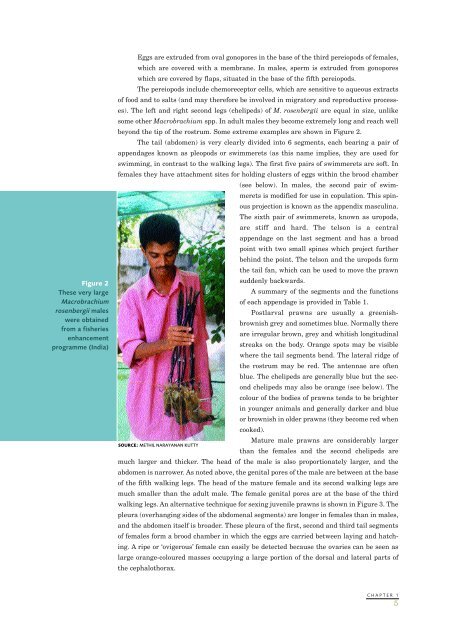Create successful ePaper yourself
Turn your PDF publications into a flip-book with our unique Google optimized e-Paper software.
Figure 2These very largeMacrobrachiumrosenbergii maleswere obtainedfrom a fisheriesenhancementprogramme (India)Eggs are extruded from oval gonopores in the base of the third pereiopods of females,which are covered with a membrane. In males, sperm is extruded from gonoporeswhich are covered by flaps, situated in the base of the fifth pereiopods.The pereiopods include chemoreceptor cells, which are sensitive to aqueous extractsof food and to salts (and may therefore be involved in migratory and reproductive processes).The left and right second legs (chelipeds) of M. rosenbergii are equal in size, unlikesome other Macrobrachium spp. In adult males they become extremely long and reach wellbeyond the tip of the rostrum. Some extreme examples are shown in Figure 2.The tail (abdomen) is very clearly divided into 6 segments, each bearing a pair ofappendages known as pleopods or swimmerets (as this name implies, they are used forswimming, in contrast to the walking legs). The first five pairs of swimmerets are soft. Infemales they have attachment sites for holding clusters of eggs within the brood chamber(see below). In males, the second pair of swimmeretsis modified for use in copulation. This spinousprojection is known as the appendix masculina.The sixth pair of swimmerets, known as uropods,are stiff and hard. The telson is a centralappendage on the last segment and has a broadpoint with two small spines which project furtherbehind the point. The telson and the uropods formthe tail fan, which can be used to move the <strong>prawns</strong>uddenly backwards.A summary of the segments and the functionsof each appendage is provided in Table 1.Postlarval <strong>prawns</strong> are usually a greenishbrownishgrey and sometimes blue. Normally thereare irregular brown, grey and whitish longitudinalstreaks on the body. Orange spots may be visiblewhere the tail segments bend. The lateral ridge ofthe rostrum may be red. The antennae are oftenblue. The chelipeds are generally blue but the secondchelipeds may also be orange (see below). Thecolour of the bodies of <strong>prawns</strong> tends to be brighterin younger animals and generally darker and blueor brownish in older <strong>prawns</strong> (they become red whencooked).SOURCE: METHIL NARAYANAN KUTTYMature male <strong>prawns</strong> are considerably largerthan the females and the second chelipeds aremuch larger and thicker. The head of the male is also proportionately larger, and theabdomen is narrower. As noted above, the genital pores of the male are between at the baseof the fifth walking legs. The head of the mature female and its second walking legs aremuch smaller than the adult male. The female genital pores are at the base of the thirdwalking legs. An alternative technique for sexing juvenile <strong>prawns</strong> is shown in Figure 3. Thepleura (overhanging sides of the abdomenal segments) are longer in females than in males,and the abdomen itself is broader. These pleura of the first, second and third tail segmentsof females form a brood chamber in which the eggs are carried between laying and hatching.A ripe or ‘ovigerous’ female can easily be detected because the ovaries can be seen aslarge orange-coloured masses occupying a large portion of the dorsal and lateral parts ofthe cephalothorax.CHAPTER 15
















